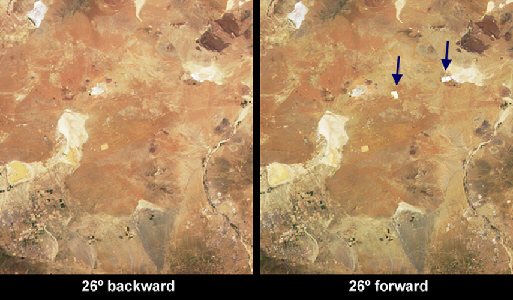Erin Schumacher's summer job for NASA was to look for UFOs. Erin is a 16-year-old high school student from Redondo Beach, California, attending the California Academy of Mathematics and Science in Carson. She was one of ten students selected to work at NASA's Jet Propulsion Laboratory (JPL) in Pasadena as part of the Summer High School Apprenticeship Research Program, or SHARP.
But is studying UFOs a useful kind of NASA research? Well, it is when they are "unidentified flashing objects" that appear in certain images of Earth from space. Erin worked with scientists on the Multi-angle Imaging SpectroRadiometer (MISR) project to track down these mysterious features. MISR is one of five instruments onboard the Earth-orbiting Terra satellite. MISR's nine separate cameras all point downward at different angles, each camera in turn taking a picture of the same piece of Earth as the satellite passes overhead. Viewing the same scene through the atmosphere at different angles gives far more information about the aerosols, pollution, and water vapor in the air than a single view would give. Ground features may also look slightly or dramatically different from one viewing angle to another.
Erin's job was to carefully examine the pictures looking for any flashes of light that might be visible from just one of the nine angles. Such flashes are caused by sunlight bouncing off very reflective surfaces and can be seen if a camera is pointed at just the right angle to catch them. Because the satellite data contain precise locations for each pixel in the images, Erin could figure out exactly where a flashing object on the ground should be. Her job was then to figure out exactly what it was that made the flash-in particular, to see if she could distinguish man-made objects from natural ones.
When Erin began working at JPL, scientists on the MISR project had already identified two large flashes out in the middle of the Mojave Desert in Southern California. These turned out to be from solar power generating stations. Soon, Erin began finding flashes all over the place. She learned how to apply her math knowledge to figuring out how the objects would have to be oriented in order to be seen by a particular MISR camera. One time, she and a team of MISR scientists and students went on a field trip to the exact locations of some flashes, where they found greenhouses, large warehouses with corrugated metal roofs, a glass-enclosed shopping mall, and a solar-paneled barn. For some flashes, they could find nothing at all. Those remain "UFOs" to this day!
Two
cameras on MISR made these images of the same part of the Mojave
Desert. The camera pointed at an angle of 26 forward saw the
flashes from two solar electric power generating stations. These
objects are nearly invisible at the other angle.
Learn more about SHARP at www.nasasharp.com and Earth science
applications of MISR at www-misr.jpl.nasa.gov. Kids can
do an online MISR crossword at
spaceplace.nasa.gov/en/kids/misr_xword/misr_xword1.shtml.
This article was written by Diane K. Fisher. It was provided
by the Jet Propulsion Laboratory, California Institute of Technology,
under a contract with the National Aeronautics and Space
Administration


